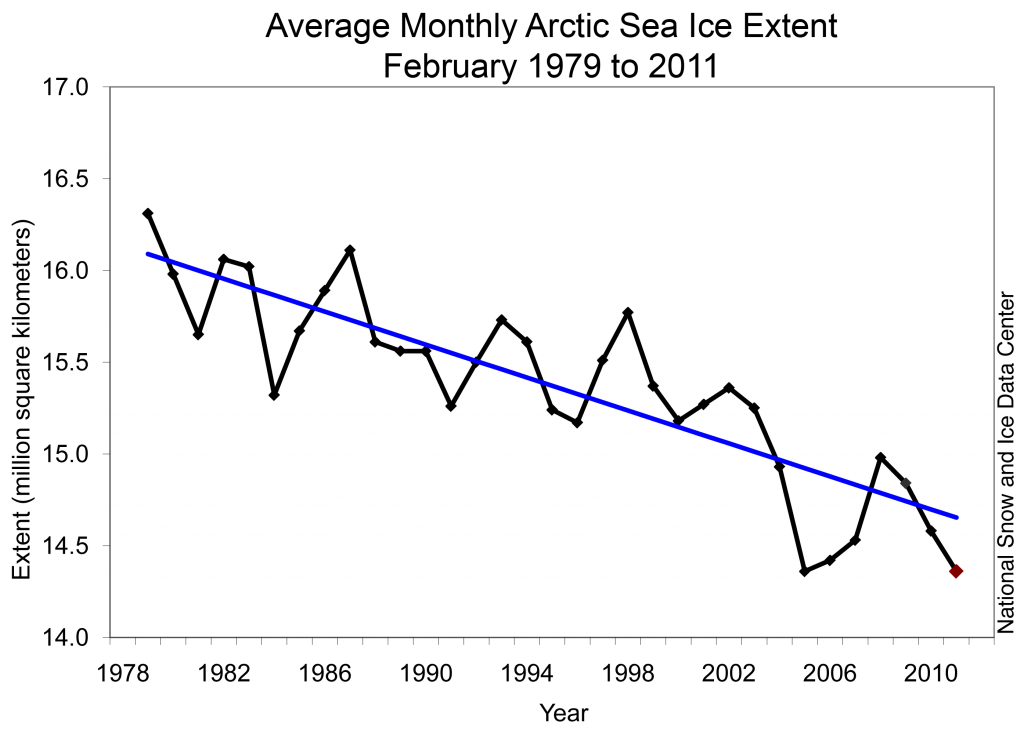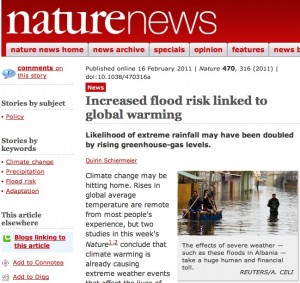3 March 2011
February Arctic Ice Ties 2005 for Lowest On Record
Posted by Dan Satterfield
The decline in Arctic sea ice continues. Image from NOAA-NSIDC.
The National Snow Ice Data Center released updated ice data today and the decline continues. The average ice cover in February was 14.36 million sq. km. This ties with February 2005 for lowest recorded in the month.
The ice over the last year has continued to track at, or below, the all time record low year in 2007. The ups and downs on that graph are the different weather patterns in each past February. The steady long term decline is almost certainly due to increasing greenhouse gases in the atmosphere.
While on the subject of climate science, there have been some very notable papers published recently. Both got some media attention, but they were much bigger news in the science world. Nature published two papers that linked heavy precipitation events to the rising greenhouse gases.
The correct response to the question whether a flood or snow storm was caused by climate change is to say that no one event can be ascribed to it. Climate change just makes it more likely to happen. You might wonder how climate change could make a heavy snow more likely, but the answer is pretty straight forward.
Warmer air can contain more water vapor. The atmosphere has warmed about 0.8C in the last 100 years. Most of this in the last 50 years and therefore it now holds about 4% more water vapor. This cannot be ignored and several researchers have looked for the human fingerprint of this in heavy precipitation events. (The water vapor increase rate is about 7%/degree C.)
NATURE NEWS has a great summary of the two papers and why they are important. You can read this summary even without a subscription to NATURE. The guy down the street who thinks climate change is a liberal commie plot will not pay much attention to it, but as Quirin Schiermer writes in Nature News, local governments and insurance companies will.
The first paper is entitled Human contribution to more-intense precipitation extremes.
NatureVolume: 470,pages: 378–381Date published:(17 February 2011)DOI:doi:10.1038/nature09763
The authors compared the observed increase in heavy precipitation events with a set of climate models. Some models had rising greenhouse gases consistent with what is actually occurring, and in others greenhouse gases held steady. The models with the real world depicted showed the increase in heavy precipitation events. The models that ignored the rising greenhouse emissions did not.
This is a powerful confirmation of something that several fellow meteorologists (myself included) have noticed. The weather is doing things it did not do before. Saying that and showing it scientifically are two separate things, but this paper does just that. If anything, the models seem to be underestimating the effect that the rising emissions are causing.
This is from the abstract:
Here we show that human-induced increases in greenhouse gases have contributed to the observed intensification of heavy precipitation events found over approximately two-thirds of data-covered parts of Northern Hemisphere land areas. These results are based on a comparison of observed and multi-model simulated changes in extreme precipitation over the latter half of the twentieth century analysed with an optimal fingerprinting technique. Changes in extreme precipitation projected by models, and thus the impacts of future changes in extreme precipitation, may be underestimated because models seem to underestimate the observed increase in heavy precipitation with warming.
The other paper looked at a specific event. The year 2000 England/Welsh floods. The authors of this paper ran high resolution simulations with increasing greenhouse gases and without. The results were astounding. Here is what they said:
The precise magnitude of the anthropogenic contribution remains uncertain, but in nine out of ten cases our model results indicate that twentieth-century anthropogenic greenhouse gas emissions increased the risk of floods occurring in England and Wales in autumn 2000 by more than 20%, and in two out of three cases by more than 90%.
These kind of high resolution model runs require LOTS of computer time, and the authors used thousands of idle home computers to do it! You can help too; just go to climateprediction.net.
The NY Times did an excellent story on this as well here.





 Dan Satterfield has worked as an on air meteorologist for 32 years in Oklahoma, Florida and Alabama. Forecasting weather is Dan's job, but all of Earth Science is his passion. This journal is where Dan writes about things he has too little time for on air. Dan blogs about peer-reviewed Earth science for Junior High level audiences and up.
Dan Satterfield has worked as an on air meteorologist for 32 years in Oklahoma, Florida and Alabama. Forecasting weather is Dan's job, but all of Earth Science is his passion. This journal is where Dan writes about things he has too little time for on air. Dan blogs about peer-reviewed Earth science for Junior High level audiences and up.
If you are looking for that ice, it’s in my yard. Well at least some of it.
We are getting more snow than we used to here in NE Ohio but it is much warmer, the rivers do not ice over enough to skate anymore, not in the last 15-20 years. 30 years ago, skating was safe for two months each winter on the rivers and the pond ice was good for 5 months. Great for sledding and my oil bill but not so good the blades.